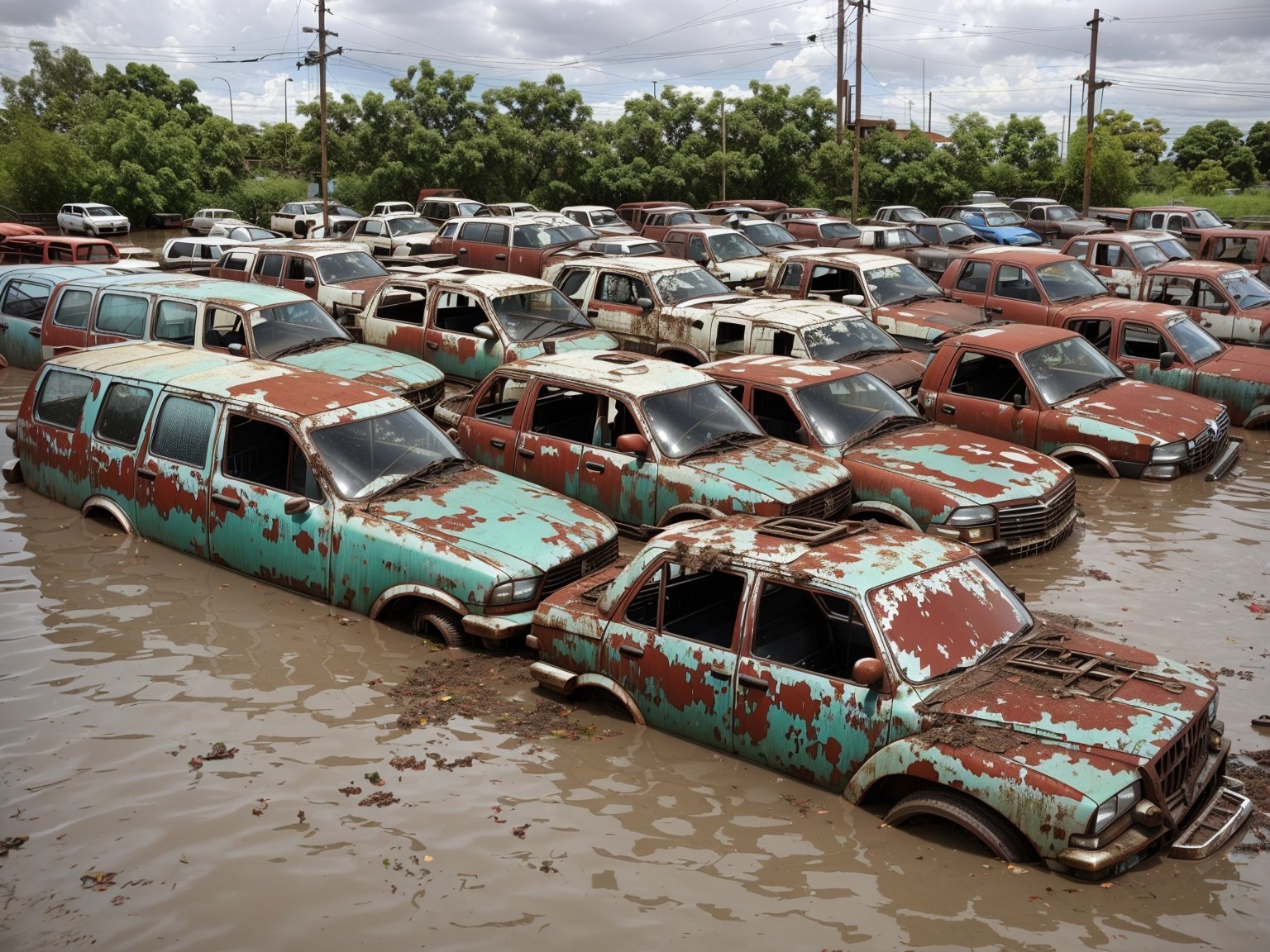
Understanding Flood-Damaged Vehicles
Flood-damaged vehicles can be tempting due to their lower cost, yet they come with their own set of complications that potential buyers need to be aware of. Generally, a flood-damaged car has been submerged in water, which can lead to significant mechanical, structural, and electrical problems that might not be immediately apparent. The water can wreak havoc on the engine, transmission, and drivetrain, often resulting in issues with the vehicle’s electrics, including the onboard computer systems that virtually all modern cars rely on.
Despite the potential for significant savings upfront, deciding to buy a flood-damaged car can present a plethora of challenges down the line. Insurance companies have their categorizations and coverages for flood-damaged cars, which may complicate any claims or procedures in the future. Furthermore, the sheer unpredictability of existing and potential damage is problematic. Given the wide range of potential issues, and the associated costs that may arise later, one has to weigh up if it’s worth the risk.
The Financial Aspect: The Lower Purchase Price
When considering the financial aspect, the lower purchase price of a flood-damaged car can be initially appealing. After a flood, damaged cars are often priced significantly lower than their undamaged counterparts. This reduction can be quite substantial, making them a tempting choice for budget-conscious buyers. Economic considerations lend themselves to this decision, as the immediate savings from buying a flood-damaged car can be used for maintenance or repair costs.
However, one must weigh the pros and cons of buying a flood-damaged car. It is essential to understand that the lower purchase price often reflects the degree of flood damage the car has sustained. While the initial price may appear cheap, the potential hidden costs of a flood-damaged car should never be overlooked. Car buyers must decide if buying a flood-damaged car is worth the risk, considering future repairs, insurance complications, long-term maintenance, and potential resale obstacles. Although the initial monetary saving could be significant, these hidden factors might outweigh the benefits in the long run.
The Potential for Hidden Damages
Consider buying a used car. The waters can get quite murky when that car happens to be flood-damaged. Damaged cars, particularly those impacted by floods, carry a high risk of hidden damage, often not immediately visible to the untrained eye. Water damage is insidious, and the effects can manifest over time, affecting various systems and components of the car. Thus, repair and maintenance costs can mount up significantly over time.
The pros and cons of buying a flood car must be carefully weighed. One of the pros of buying such cars is their reduced upfront cost. However, it’s essential to factor in the long-term implications. This includes insurance complications; some insurance companies might deny comprehensive insurance coverage for flood-damaged cars. Furthermore, cars sold with a history of flood damage carry a stigma in the resale market, reducing their value substantially. Therefore, buying one requires a cautious analysis and understanding of the potential hidden damages.
Insurance Complications with Flood-Damaged Cars
Securing insurance for a flood-damaged car can be challenging. Insurance companies often consider these vehicles high risk due to the extensive issues flood damage can cause under the hood. The difficulties arise due to the unpredictable nature of water damage – it can lead to rust, affect the car’s electrical components, and damage the interior over time. So, if you buy a flood-damaged car, prepare yourself for possible insurance hurdles.
Choosing the right mechanic to inspect the car before purchase can help mitigate the risks. This inspection primarily aims to assess the repair required and the extent of the flood damage. However, even if you buy a flood-damaged used car after a thorough inspection, bear in mind that the car may still present complications, potentially escalating long-term costs.
Long-Term Maintenance Costs

When buying a used car, especially a salvage or flood-damaged one, it’s imperative to understand the potential long-term costs. Flood-damaged cars are often more susceptible to extensive damages than their pristine counterparts. For instance, even if the carpet and upholstery have been meticulously dried and cleaned after the vehicle flooding, hidden damages such as mold or mildew could pose health risks over time. Even more concerning, the vehicle’s electrical system, once exposed to water, may progressively develop problems. These issues might not be immediately apparent but could cost thousands of dollars in maintenance.
Before buying a flood-damaged car, getting a vehicle history report from the National Insurance Crime Bureau is advisable. This can alert potential buyers to a salvage title, signaling that the damaged vehicle could entail substantial long-term maintenance costs. In addition, a professional inspection is recommended to assess such hidden problems. All these factors contribute to the pros and cons of buying a flood-damaged vehicle, making it a decision worth the risk for some, while others may prefer to steer clear. This might be a worthwhile endeavor for those who are mechanically inclined or looking to invest time and money into a project car. However, such buyers should still be aware and prepared for potential maintenance issues.
Resale Value: A Significant Drawback
The process of buying a used car comes with a lot of considerations, especially if the car has been flooded or affected by a flood. A flood-damaged car may appear to be a very attractive deal, given their lowered price, but the true extent of the damage is often discovered much later. Signs of water damage can disguise serious hidden damages, which might only surface after purchase. In particular, cars submerged in salt water could have hidden corrosion that only surfaces over time.
Insurance coverage presents another key challenge when dealing with flood-damaged vehicles. Flood-damaged cars are often listed as “salvage” or “totaled” by car insurance companies, indicating they were severely damaged. This negatively impacts their resale value. When buying a car, potential buyers usually prefer a used vehicle without a significant damage history. Hence, a car with a flood damage history will not fetch a comparable value to a similar model without such history. This consideration is key in deciding whether purchasing a flood-damaged car is financially wise.
How to Identify a Flood-Damaged Car
Thousands of cars are damaged each year through encounters with flood water, yet many end up in used car lots across the nation, posing as ordinary second-hand vehicles. The hazards of buying these flood affected cars are numerous, that’s because flood-damaged cars harbor many potential issues. For one, flood-damaged cars can’t be registered if the owner didn’t have comprehensive insurance when the car was flooded. Additionally, these vehicles may harbor hidden rust or other damage that can lead to significant issues.
The damage from flood water gets into the mechanical, hydraulic, and electrical systems, making them ticking time bombs of potential problems. Despite the “possibility of flood damage”, many unscrupulous sellers will still attempt to sell these vehicles to unsuspecting buyers. Be vigilant when buying a used car and look for signs of flood damage such as drain plugs under the car. If you suspect a car had been flooded, you’ll want to avoid buying it, regardless of the cons of buying a flood-damaged vehicle. Knowing the risks and how to identify the signs of a flood-damaged car could save you from a troublesome purchase.
Steps for Safely Buying a Flood-Damaged Car
Navigating through buying a flood-damaged car involves a high degree of caution against potential risks. The journey starts with getting a detailed history of the car to evaluate the extent of the damage it might have undergone; for instance, cars swamped in several feet of water often have more severe damage than those in less water. This can give crucial insights into whether the car was damaged or destroyed in the flooding. Armed with this information, carfax offers a free flood check on the specific car identified for purchase, which can help identify if the car is worth buying, because some cars are repaired and resold after a flood.
Another integral step in wanting a car that has had a major flooding issue is to ensure the damage is properly disclosed by the seller. This is especially important since some cars totaled out by insurance companies due to flood damage are often still bought and sold. When such a flood-damaged car comes into the market, a prospective buyer needs to consider its implications on the life of the car, the reduced resale value, and potential long-term maintenance costs, as well as the complications it might pose with insurance. Always pursue a professional inspection of the car before buying it; this step is indispensable when you’re considering to buy the car regardless of its past and on the bottom line, knowing for sure if the car is totaled allows to assess the situation comprehensively.
The Role of Professional Inspection
Having an expert inspect a car is essential before you consider buying a vehicle that is known, or even suspected, to be flood-damaged. Flood-damaged cars are often sold with an appealingly low upfront price, but various problems can soon dwarf this initial investment. Damage that may not be immediately noticeable can manifest in many parts of the car, from the engine to the upholstery. An experienced inspector knows where to look for these signs of flood damage and can provide a detailed report about the extent of the damage and an estimate for the repair cost.
Electrical damage is one of the chief issues for cars due largely to the sophisticated technology integral to modern vehicles. When buying a car or truck that’s been insubstantially cleaned and presented as in good working order, the water and sediment of a flood can damage the car’s electronic components, causing serious malfunctioning and unsafe driving conditions. Additionally, the impact of flood damage can affect the vehicle’s structural integrity, rusting the steel components and weakening the chassis. A flood-damaged car has many hidden potential issues that may not be immediately noticeable to the untrained eye. Having a professional put the car through a comprehensive inspection is a sound and important decision before purchasing a vehicle damaged in a flood.
Final Thoughts: Is it Worth the Risk?
In car shopping, the enticing factor of a significantly lowered purchase price often brings flood-damaged cars up for sale at the forefront. Many may see a cost-effective opportunity in such a case, especially with the pros of buying a car at a cheaper rate. However, it’s important to remember that these vehicles have experienced a reported flood event, which may have caused extensive damage. Flooding, particularly as damaging as salt water, can affect every aspect of a car, leading to mechanical and electrical problems that may not be immediately visible.
Car shoppers should also consider potential problems when buying a flood-damaged car. Even though a car may seem in good condition initially, the damage caused by flooding often leads to prolonged and recurring issues down the line. The resale value of a car that has suffered flood damage is also typically lower, further complicating the financial calculations. Therefore, while some may find the reduced initial investment attractive, it is crucial to be fully aware of the potential risks before purchasing. Repeated maintenance may end up negating the initial savings or even end up costing more.










Leave a Reply